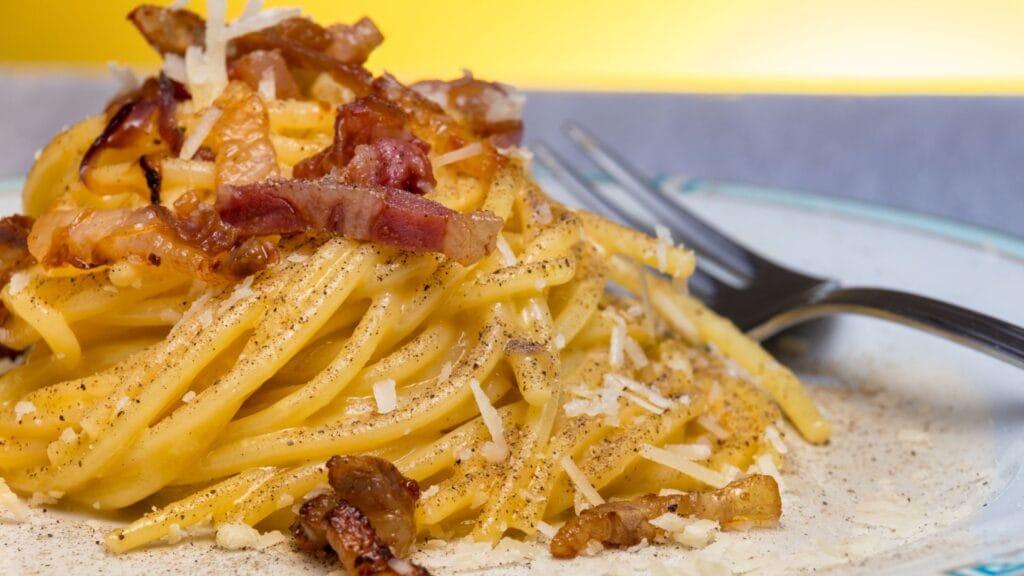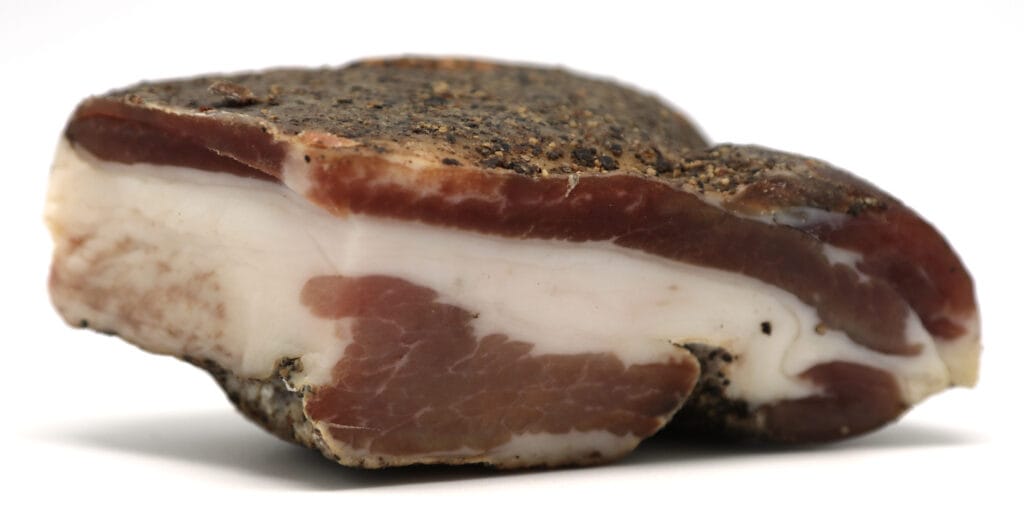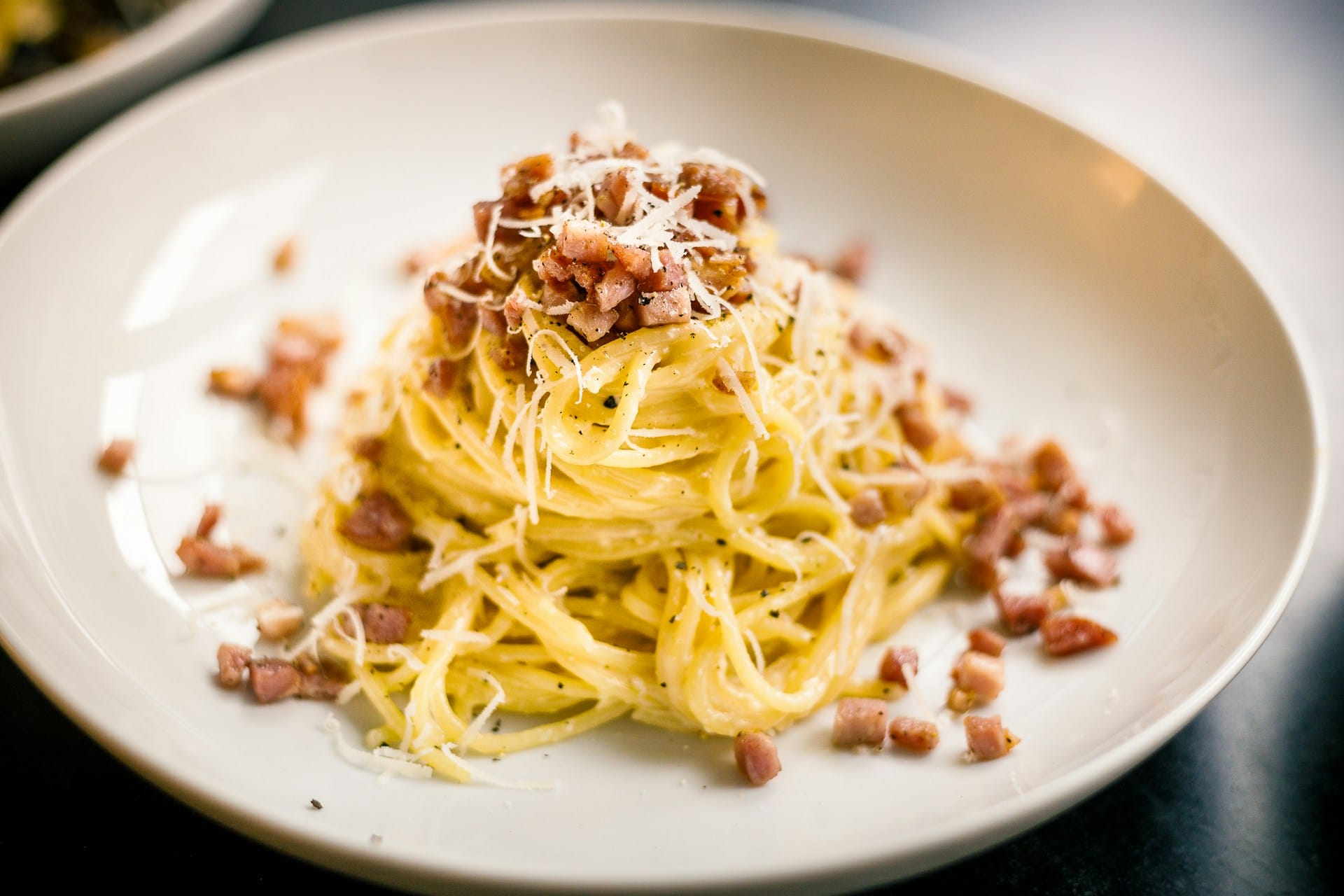Table of Contents
What is Carbonara?
Carbonara is a culinary masterpiece adored not just in Italy but worldwide. It’s a quintessential Italian dish with simple yet luxurious ingredients: spaghetti, a creamy sauce made from raw beaten eggs, crispy guanciale, grated Pecorino Romano, and freshly ground black pepper. The charm of spaghetti carbonara lies in its simplicity and the perfect balance of flavors.
The traditional recipe showcases the best of Italian cuisine, with no need for fancy ingredients or elaborate techniques. However, mastering this dish is a rewarding challenge for beginners and seasoned cooks alike. If you’re passionate about learning Italian online, this dish is a great introduction to understanding Italian culinary traditions.

Traditional vs. Modern Variations
The classic authentic Italian carbonara recipe adheres to strict rules: no butter, cream, or garlic. Italian food purists treasure the original preparation, viewing it as a sacred symbol of their culinary heritage.
Yet, outside of Italy, chefs have created countless versions of carbonara. These variations stem from cultural fusion and creativity. While some modern twists enhance the dish’s versatility, others—such as the controversial French-style “Carbonara”—spark outrage among traditionalists. This version, featuring farfalle, bacon, and crème fraîche, is considered a complete departure from the original recipe.
Cooking traditional spaghetti alla carbonara allows you to experience authentic Italian cuisine. However, experimenting with new ingredients can lead to delightful results. Whether you’re learning this dish through online Italian courses or exploring recipes on your own, it’s essential to respect its roots while embracing its adaptability.
The “Carbonaragate” Controversy
The global appeal of carbonara sometimes leads to culinary debates. The infamous “Carbonaragate” controversy ignited when a French cooking channel shared a one-pot version of carbonara. This version, involving bacon, onions, and a cream-based sauce, deviated significantly from the classic pasta carbonara preparation.
For Italians, carbonara is more than food; it’s a cultural treasure. The outrage sparked by such interpretations underscores the importance of preserving authenticity.
The History of Carbonara
The origins of traditional carbonara are as rich and complex as its flavor. Most commonly associated with Rome and the Lazio region, its exact beginnings remain a topic of debate:
- Naples Connection: Some trace carbonara’s roots to 19th-century Neapolitan cookbooks, suggesting it evolved from traditional dishes like Cacio e Ova.
- World War II Influence: Another theory links carbonara’s creation to American soldiers in Italy during World War II. Their rations of eggs and bacon inspired Italian cooks to create this dish.
- Charcoal Burners: The name “Carbonara” might reference “Carbonai” (charcoal burners) who cooked a similar dish while working in remote areas.
Whether you’re diving into Italian history through learning Italian online or studying the language while perfecting this recipe, learning about carbonara deepens your appreciation for its cultural significance.
How to Make Traditional Carbonara
For those eager to try their hand at the original Roman carbonara dish, here’s a simple yet effective guide:
- Ingredients You’ll Need:
- 400g spaghetti (or other long pasta)
- 150g guanciale (cut into small cubes)
- 3 large eggs (2 yolks + 1 whole egg)
- 100g Pecorino Romano cheese (finely grated)
- Freshly ground black pepper
- Step-by-Step Instructions:
- Boil the spaghetti in salted water until al dente.
- While the pasta cooks, sauté the guanciale over medium heat until crispy. Remove from heat.
- In a bowl, whisk eggs and Pecorino Romano. Add a generous amount of black pepper.
- Reserve some pasta water, then drain the spaghetti.
- Toss the hot pasta with the guanciale, allowing its heat to slightly cook the egg mixture. Add reserved pasta water as needed to create a creamy sauce.
Cooking authentic spaghetti carbonara requires practice and attention to detail, but the result is worth every effort!

Learning Italian Culture Through Food
Food is a powerful way to connect with a country’s culture. For those pursuing online Italian courses, dishes like carbonara offer an immersive experience. By understanding the ingredients, techniques, and history behind iconic recipes, you gain insight into Italy’s traditions.
Explore more about Italian cuisine and culture on our Culture Blog or listen to our engaging Italian Podcast for cultural tips and stories.
Why Take Online Italian Courses?
If you’re passionate about Italian cuisine and want to deepen your knowledge, enrolling in online Italian classes is an excellent choice. These courses often blend language learning with cultural insights, making the process engaging and rewarding.
- Flexibility: Study Italian online at your own pace.
- Cultural Immersion: Explore the best way to learn Italian online by incorporating cooking and history lessons.
- Convenience: Access classes from anywhere, anytime.
Learn more on our online courses page or join our YouTube channel for free video lessons.
For additional free resources, follow us on Facebook and stay connected with a community of Italian learners.
Conclusion
Carbonara is more than a recipe; it’s a testament to Italy’s rich culinary traditions and global influence. From its debated origins to its modern interpretations, this dish embodies the versatility and adaptability of Italian cuisine.
As you explore traditional carbonara, consider taking Italian courses online to deepen your connection to Italy’s culture. Whether you’re preparing an authentic recipe or experimenting with variations, learning about carbonara enhances your appreciation for Italian traditions.
Embrace the joy of cooking, and don’t forget to share this iconic dish with friends and family. Buon appetito!


[…] 4 large egg yolks (some recipes include 1 whole egg) […]